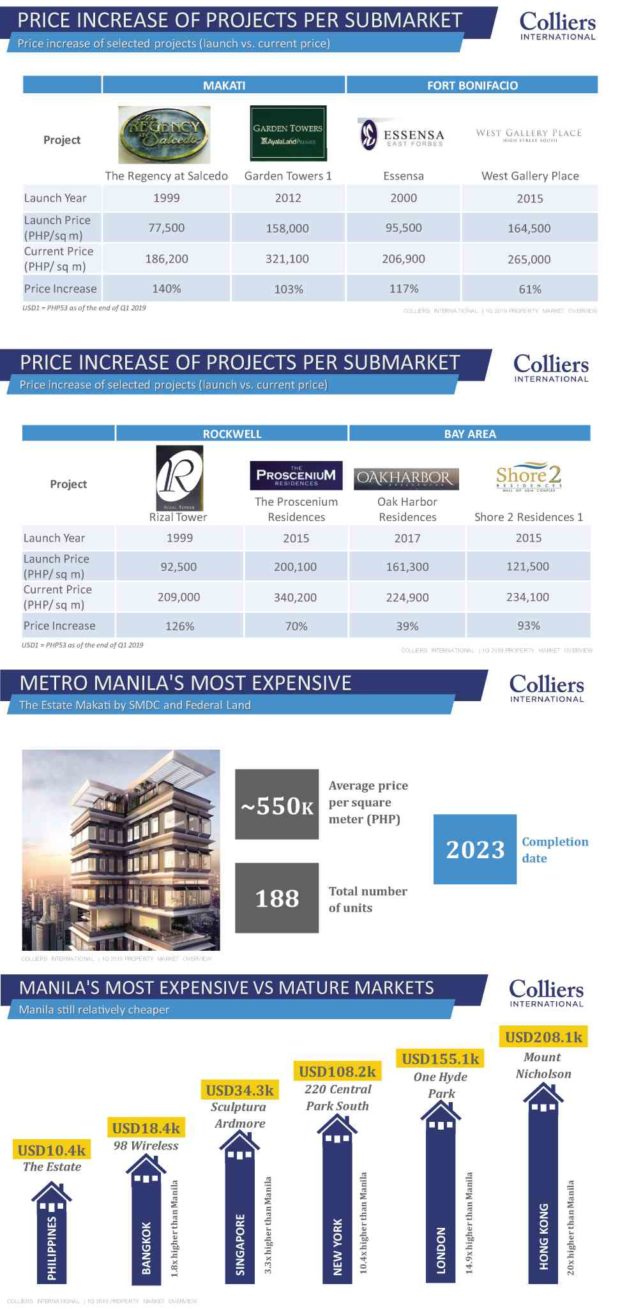Breaking the price barrier

With a total of 188 units, the average total contract price is in excess of P100 million. To put this in context, the most expensive in Manila before this was Ayala Land’s Park Central Towers priced at only P400,000 per sqm. Not that this is chump change.
The rise of ultra-luxury residential projects is not just in Metro Manila, as we have seen prices in the provinces escalate to levels that break records In Cebu, Rockwell’s Aruga Resort and Residences-Mactan is close to P260,000 per sqm while in Davao, Ayala Land’s Azuela Cove South Tower pushed prices close to P200,000 per sqm.
Just how fast has residential prices risen?
All locations would have done well in terms of price appreciation. Luxury residential units would have appreciated by 4 percent a year for developments bought after the 1997 Asian crisis. Reflecting how prices have escalated in the last five years, Makati CBD prices are up by a compounded average growth of 11 percent a year; 13 percent in Fort Bonifacio; and 14 percent in Rockwell Center. Outpacing all locations is the Bay Area, where prices have risen at an average of 18 percent per year.
In terms of demand, Colliers estimates that pre-sale projects in the luxury segment in Metro Manila have sold 83 percent of their inventory. We attribute the demand for luxury condominiums in Manila to the following.
Article continues after this advertisementCapital appreciation
Article continues after this advertisementInvestors have been attracted to the prospects of a bullish property sector that has seen prices growing more than 10 percent a year in the last five years. This is in addition to the rental income that they could derive from their property.
Return of quality stock
We are seeing a resurgence of large three-bedroom prime condominiums. The pause after the 1997 Asian crisis had developers churning out small condominium units (mostly studio and one-bedroom configurations) to address the issue of affordability. This was the period when low monthly payments for studio units below 30 sqm appeared. The encouraging sales take up of Discovery Primea (2008) and Two Roxas Triangle (2013)—which tested the market again for luxury apartments with mostly three bedrooms—prompted other developers to follow suit.
Condominium living has been widely adopted in Metro Manila with the convenience of living within the key business districts, coupled with the traffic situation in the metro. Luxury condominiums have attracted a wide spectrum of end users from singles to empty nesters.
Enter the ‘Dragon’
The current influx of Philippine offshore gaming operators (Pogo) has had a significant effect on the residential market. It is estimated that nearly 800,000 sqm of office space are being occupied by this segment. With office occupation comes the residential requirement for the employees. This has pushed prices in areas where Pogo operations are prevalent such as Makati CBD and the Bay Area.
Unique offering
The slew of designers and star architects will definitely result in an interesting Manila skyline in the future. As price levels are breached, buyers will be demanding more from developers. This will be in the form of innovative amenities and facilities, connectivity to masterplanned communities and a higher level of concierge service to address the requirements of more discerning buyers.
Does the current residential pricing have legs to run? While it may seem that we have reached a ceiling with the current price, it should also be taken in the regional context.
Yes, compared to pricing in Bangkok where the top development is nearly twice the price of the most expensive in Manila on a per square meter basis and Singapore, at 3.3 times. You can even negate the comparison to the top cities of the world such as New York (10.4 times), London (14.9 times) and of course the most expensive in Hong Kong (20 times).
Looking at regional prices, it appears that we are just scratching the surface.
